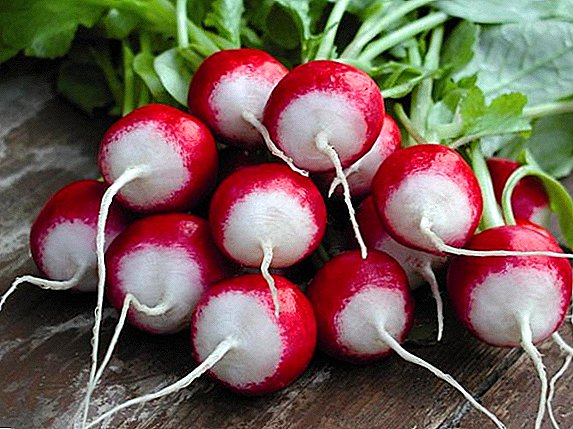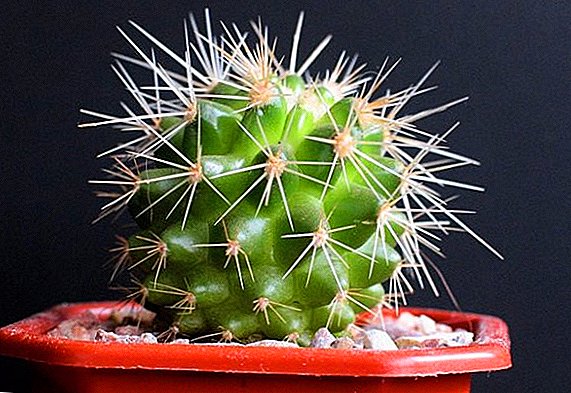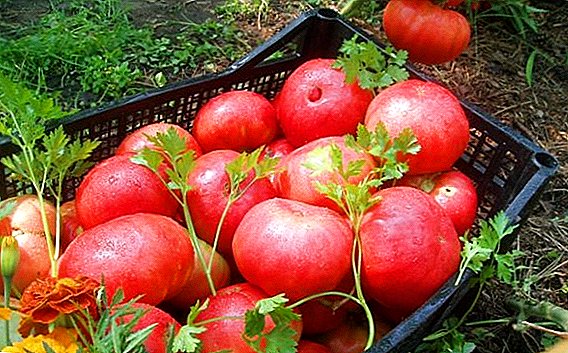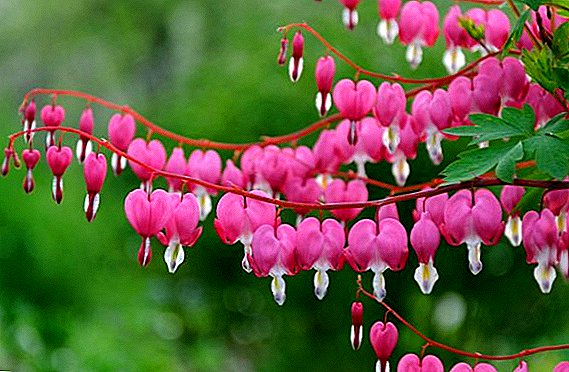 Monarda is an aromatic and medicinal flower. This is a flowering ornamental plant with two-story bright flowers. Monarda has a lemon flavor. This plant has many names: wild bergamot, golden lemon balm, Indian nettle.
Monarda is an aromatic and medicinal flower. This is a flowering ornamental plant with two-story bright flowers. Monarda has a lemon flavor. This plant has many names: wild bergamot, golden lemon balm, Indian nettle.
Did you know? Essential oil of Monarda has bactericidal properties and anthelmintic activity.
Varieties of monarda
Double - This is the most common type of plant. Grows in the wild in the North America region, reaches 80 cm in height. In a culture there since 1656. It has different color options, the flowers are small and collected in the capitate inflorescence, which reaches 6 cm in diameter.
 Monarda Dudchataya (tubular). The homeland of this species is Mexico and California. The plant is higher than the double-faced monarda, there are more branches. The stems of the plant reach 120 cm in height. Flowers are small, collected in spherical heads. Each stalk has 5-9 inflorescences up to 7 cm in diameter.
Monarda Dudchataya (tubular). The homeland of this species is Mexico and California. The plant is higher than the double-faced monarda, there are more branches. The stems of the plant reach 120 cm in height. Flowers are small, collected in spherical heads. Each stalk has 5-9 inflorescences up to 7 cm in diameter.
There is also a dwarf form of the duoish monard. They grow up to 35 cm, with lavender flowers.
Mulard hybrid. This is a combination of varieties of double and fiery monard. The plant reaches 100 cm in height. Flowers are varied.
These three types of monarda are the most common, as they are all decorative and very fragrant. All this is due to the high content of essential oils in the plant.
Lemon citrus grows in the wild USA and Mexico. Differs plant in that the leaves, flowers and stems strongly smell of lemon, mint and zest. It is used as a spice and ornamental plant.
There are also different varieties of Monarda:
"Mahogany" is an early variety. The flowers are dark red, the petals are twisted at the ends. Blossoms to frost.
"Adam" has scarlet flowers, grows exclusively in the sun.
 Croftway Punk is the most attractive lilac-pink variety.
Croftway Punk is the most attractive lilac-pink variety.
"Snow White" has pure white flowers. Effectively looks plant in single-plantings.
"Panorama" is crimson, pink, purple, white, red and purple. Flowers can be grown by combining them with other plants.
Did you know? Monardo is used to flavor tinctures and wines.
Where and how best to plant a monard
Growing monarda does not require a lot of effort. The plant is best planted in a sunny place on light soils, as the plant develops poorly in wet and acidic soil.
The site for the plant is prepared in the fall, cleaning it from weeds, digging and fertilizing the soil with peat, manure, potash salt and superphosphate. Planting Monarda begin in the spring, periodically fertilizing the plant with nitrogen fertilizer.
If you decide to grow Monarda with seeds, then this should be done in February. It is sown directly into the ground, and within two months the plant undergoes a natural stratification.
In April, you can expect the first strong shoots. If there is snow on the site, it should be removed and covered with a film, as the ground should warm up. After that, loosen the ground and add a layer of sand.
Important! Monarda rises very slowly.
 Two months later, when the plants sprout, and three pairs of leaves are formed on them, the seedlings are transferred to the prepared area. The distance between them should be about 60 cm. After planting, plenty of watering is necessary.
Two months later, when the plants sprout, and three pairs of leaves are formed on them, the seedlings are transferred to the prepared area. The distance between them should be about 60 cm. After planting, plenty of watering is necessary.
When frosts reach -5 ° C, the plant feels normal. Monarda bloom begins in a year.
Most often, florists plant a plant in a seedling way. In January-February, they are sown in boxes for vegetable crops, so that the plant will grow in spring.
You also need to mix the seeds with sand. The proportion should be 1: 4. Then they are sown with sand. Depth should be no more than 2.5 cm.
Seedlings sprout in three weeks. After that, three more weeks should pass, and new plants should be dived into containers according to the 3 by 3 scheme in order to increase the nutrition area.
Planted seedlings 3 cm apart and placed in a greenhouse. Under the film should be a temperature not lower than 20 ° C.
Did you know? Monarda was named in honor of the botanist Nicholas Monardes, who described it. From the UK, the monarda came to Europe, where it is bred with the name "Golden Melissa" or "Indian nettle".
What kind of neighbors to choose for Monarda
 Since the monard is used in landscape design, you need to know which plants it is best adjacent to.
Since the monard is used in landscape design, you need to know which plants it is best adjacent to.
In any case, you need to choose a sunny place, since for bergamot these are the best conditions for active growth and flowering. Wormwood and hydrangea combine well with this plant.
Do not forget about dahlias and phloxes. In any combination with these plants, the monard will look like a queen.
Did you know? For fractures and injuries, tea with the addition of dry or fresh Monarda herb is recommended.
Caring for the monard in your flower bed
After planting, you need to properly care for the monard, then the plant will bloom for about ten years.
After flowering, the leaves, stalks and flowers of bergamot fall. It takes place in September. Pruning can be done with garden shears.
Important! If the shrub has grown densely, you can cut several stalks or roots.
In late April, the monarda is again dissolved. When caring for this plant, remember the importance of watering and fertilizing.
In the hot season, when there is a danger of damage to the plant with powdery mildew, it is important to make timely watering of the monardy.
Do not let the plants dry out. Otherwise, the monard can be affected by a fungal disease.
 At the peak of the heat it is necessary to water the plant daily. Also in the dry summer, you need to mulch the area with plant leaf humus and peat. This should be done in spring and autumn. Often you need to remove weeds and loosen the ground. This will ensure the plant rapid growth and abundant flowering.
At the peak of the heat it is necessary to water the plant daily. Also in the dry summer, you need to mulch the area with plant leaf humus and peat. This should be done in spring and autumn. Often you need to remove weeds and loosen the ground. This will ensure the plant rapid growth and abundant flowering.
Also care includes fertilizing bergamot. This should be done with granulated "Kemira" or "Agricola". Feeding is carried out every two weeks from mid-May until autumn. For prophylaxis in spring and autumn, Monarda is treated with "Fundazole" or copper sulphate.
It must be remembered that a weakened plant looks plain and blooms worse.
Did you know? Monarda has an antiviral effect, it is useful to insist and drink for colds.
How to prepare a monard for winter
The preparation of the monarda for the winter is also important, since it allows to avoid some diseases and the death of the plant.
About in the middle of October It should be cut the stems of a plant to 10 cm.
By the end of October fallen leaves should be collected in the garden, as pests or a fungal infection can live under them for the winter.
In November it is necessary to mow the lawn and remove dead elements of the plant, the remaining leaves and needles.
 Since the plant is winter-hardy, it tolerates lowering temperatures to -25 ° C, but additional protection is needed. It can be provided by mulching or laying lapnik. This will save the plant from freezing during the winter of the Monarda.
Since the plant is winter-hardy, it tolerates lowering temperatures to -25 ° C, but additional protection is needed. It can be provided by mulching or laying lapnik. This will save the plant from freezing during the winter of the Monarda.
Did you know? Monarda - one of the best remedies for the treatment of cough, bronchitis.
Breeding monarda
Now that we have fully studied the care and methods of growing the Monarda, we should proceed to the reproduction of this plant.
Since the seeds do not retain varietal characteristics, it will be safer to propagate the plant by dividing the bushes for 3-4 years.
This procedure is carried out in April or early fall. The bush is dug out, the roots are cleared from the soil under water and divided into equal parts. Sections need to be processed with crushed coal.
Then delenki planted in the fossa, which are prepared in advance. Transplantation of such delenok will have to be done two or three years after planting, as the plants grow to 1 m in diameter.
 You can propagate the plant and with the help of cuttings. They are cut from the shoots before flowering monarda. The lower leaves are removed from the cuttings, while the upper leaves are shortened by a third. The length of the cuttings should be 8-10 cm.
You can propagate the plant and with the help of cuttings. They are cut from the shoots before flowering monarda. The lower leaves are removed from the cuttings, while the upper leaves are shortened by a third. The length of the cuttings should be 8-10 cm.
Then they are planted in a box with wet river coarse sand. You should also cover the box on top and put in a dark place.
Rooted cuttings within 2-3 weeks.
Planted monard in a permanent place in the second half of the summer, and a year later a perennial plant will please your eye.
Did you know? Double papaver is used as an additive in the well-known British variety of Earl Gray tea, giving it an unusual taste.
Monarda resistance to diseases and pests
As mentioned earlier, the monard has a persistent and pleasant aroma, but it not only pleases florists, but also protects the plant from pests.
Like all plants, monarda can be subject to various diseases. It is mainly powdery mildew. Very rarely, a plant is affected by rust or tobacco mosaic virus.
 Mealy dew is a fungal disease that can be caused by rare watering of a plant. A white scatter appears on the surface of the leaves of the Monarda, on which liquid droplets form.
Mealy dew is a fungal disease that can be caused by rare watering of a plant. A white scatter appears on the surface of the leaves of the Monarda, on which liquid droplets form.
Over time, the raid becomes denser and after brown. The fungus overwinter on plant debris. The first measure to combat powdery mildew - cleaning and burning of these residues. Also should be cut in the spring affected ends of the shoots.
Powdery mildew can be overcome with the help of biofungicides, such as Fitosporin-M, Pseudobacterin-2, Planriz, and Alirin-B.
Did you know? Leaves of all kinds of Monarda have the smell of lemon and mint, they are added to meat dishes and salads.
Beautiful views, aroma, easy care and cultivation - these are not all the advantages of the Monarda. Now that you know all the secrets of growing a plant, you can safely buy seeds and grow your own miracle on your site.












